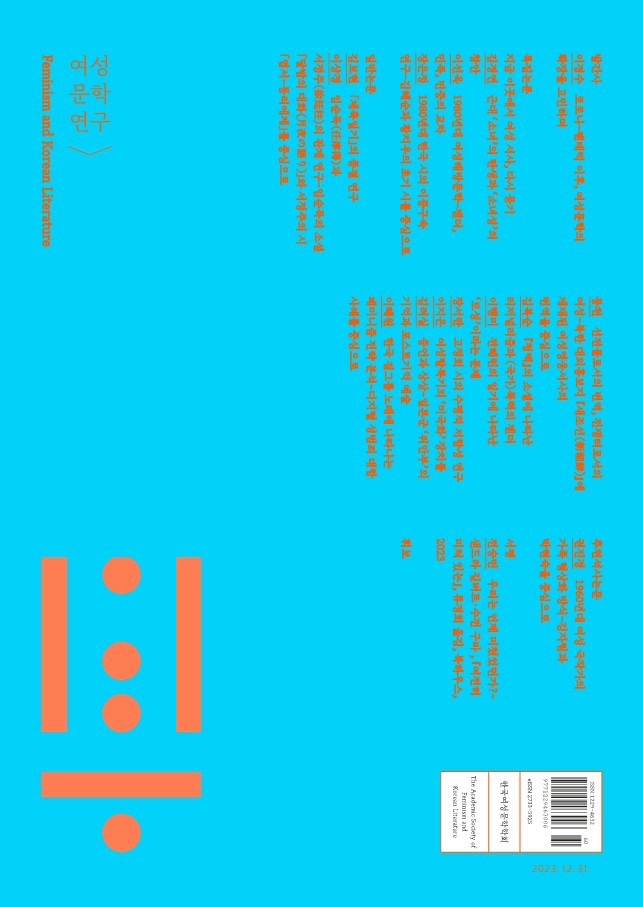- ENGLISH
- P-ISSN1229-4632
- E-ISSN2733-5925
- KCI
 ISSN : 1229-4632
ISSN : 1229-4632
복수하는 여성 원혼의 서사적 정체성
The epic identity of a vengeful female ghost
초록
한국구비설화에서 여성이 남성으로부터 버림받음으로 인해 원혼이 되어 상대 남성에게 가해하는 서사를 발견할 수 있다. 본고에서는 대표적으로 〈첫날밤 소박맞은 신부〉, 〈조월천과 상사뱀〉, 〈신립장군과 원귀〉 세 유형의 자료에 주목하여 원인사건과 복수사건으로 이루어지는 복수서사의 구조를 확인하고, 각 시퀀스 안에서 여성 주체의 존재적 속성과 관계적 속성이 달라지는 양상을 확인하였다. 여성 원혼의 복수서사는 서사적 정체성의 개념을 통해 분석했을 때 고정된 본질적속성으로서의 여성이라는 존재적 속성 때문에 발생한 문제에 대해서 관계 맺음의 과정에서 그 존재적 속성 자체를 원혼으로 변화시킴으로써 새로운 관계적 속성을 형성하고 이로써 문제 해결을 시도하는 서사로 볼 수 있다. 여성 원혼의 복수서사는 원혼 형상을 갖춘 후에야 복수 행위를 시도할 수 있었고 그 되갚음의행위가 상대 남성의 사회적 지위를 무력화시키는 방향이었다는 점에 주목하여그 성정치적 의미를 설명할 수 있다.
- keywords
- 복수, 여성 원혼, 서사적 정체성, 존재적 속성, 관계적 속성, 성정치, 〈첫날밤 소박맞은 신부〉, 〈조월천과 상사뱀〉, 〈신립장군과 원귀〉, Revenge, Female vengeful spirit, Narrative identity, Existential attribute, Relational attribute, Sexual politics, 〈The Bride Who Was Beaten on the First Night〉, 〈Jo Wolcheon and Sangsa Snake〉, 〈General Sinrip and the Vengeful Ghost〉
Abstract
In Korean traditional narratives, one can find a narrative pattern where a woman, rejected by a man, becomes a vengeful spirit and inflicts harm upon the male counterpart. In this paper, the focus is on three representative narratives: 〈첫날밤 소박맞은 신부〉(The Bride Who Was Beaten on the First Night), 〈조월천과 상사뱀〉(Jo Wolcheon and Sangsa Snake), and 〈신립장군과 원귀〉(General Shin Rip and the Vengeful Ghost). By examining these narratives, the paper investigates the structure of revenge narratives consisting of causal and retaliatory events. It also explores how the existential and relational attributes of the female protagonist change within each sequence. The revenge narratives of female spirits can be understood as an attempt to address problems that arise due to the existential attribute of “woman” as a fixed and essential characteristic. Through the concept of narrative identity, the paper argues that these narratives transform the very essence of this existential attribute into a vengeful spirit, thereby forming a new relational attribute and attempting to resolve the issue through the process of forming new relationships. The revenge narratives of female spirits highlight that revenge actions could only be attempted after taking on the form of spirits, and the acts of repayment were aimed at neutralizing the social status of the male counterpart, emphasizing the sexual political significance.
- keywords
- 복수, 여성 원혼, 서사적 정체성, 존재적 속성, 관계적 속성, 성정치, 〈첫날밤 소박맞은 신부〉, 〈조월천과 상사뱀〉, 〈신립장군과 원귀〉, Revenge, Female vengeful spirit, Narrative identity, Existential attribute, Relational attribute, Sexual politics, 〈The Bride Who Was Beaten on the First Night〉, 〈Jo Wolcheon and Sangsa Snake〉, 〈General Sinrip and the Vengeful Ghost〉
- 45다운로드 수
- 156조회수
- 0KCI 피인용수
- 0WOS 피인용수
